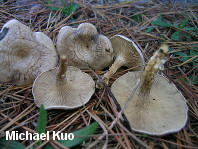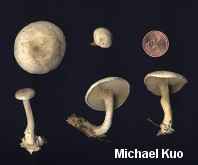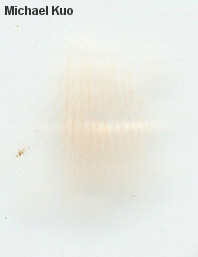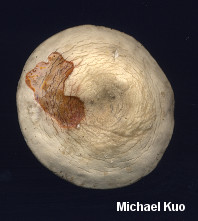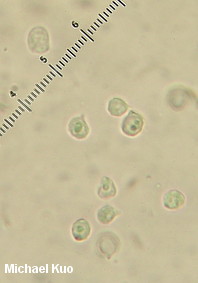| Major Groups > Gilled Mushrooms > Pink-Spored > Entolomatoid Mushrooms > Clitopilus popinalis |

|
Clitopilus popinalis [Basidiomycota > Agaricales > Entolomataceae > Clitopilus . . . ] by Michael Kuo The eastern North American version of Clitopilus popinalis (also known as Rhodocybe mundula) is fairly easily recognized. It has a whitish to grayish or dirty yellowish cap that develops a central depression and distinctive, more or less concentric cracks. Its gills run down the stem, and its spore print is pink. Other distinctive features include the mealy odor, the bitter taste, and the fact that a drop of KOH applied to any surface on the mushroom turns red. But while this entolomatoid mushroom is fairly easy to identify, figuring out which name to give it is not an easy task. If such things interest you, here goes: Which genus name? Recent research (Co-David and collaborators, 2009) supports placing species that used to belong in the genus "Rhodocybe" in an expanded Clitopilus, since DNA results showed Clitopilus to be nested within Rhodocybe, indicating one genus for the whole group; because "Clitopilus" is the older of the two names, species of Rhodocybe were transferred to Clitopilus. However, the authors transferred neither popinalis nor mundula to Clitopilus--because previous authors had already done so, and there was no need to create the new "combinations." (The two major online databases for fungal taxonomy, Index Fungorum and Mycobank, missed this subtlety when recording the new combinations from the Co-David paper, and therefore use "Rhodocybe" incorrectly as the current genus name for popinalis and mundula, despite attempting to incorporate Co-David's taxonomic suggestions.) Which species name? The question of whether Clitopilus/Rhodocybe popinalis and Clitopilus/Rhodocybe mundula are different has been troublesome for centuries. As Breitenbach & Kränzlin (1995) put it: "Despite many attempts to clarify the Rhodocybe mundula-popinalis species-complex, no useful and unequivocal differentiating features have been found. Overlapping or contradictory features are mingled in all the descriptions of these two species." Entolomatoid mushroom guru Machiel Noordeloos declared the two species to be indistinguishable in 1988 since the characters used to separate them were "intergrading and reversible," then more recently (2008) treated them as separable based on cap colors, blackish bruising for popinalis, and a difference in the "weakly pustulate to almost smooth" spores of popinalis and the "distinctly pustulate" spores of mundula . . . but these are the very characters that Noordeloos previously viewed as intergrading and reversible. Data from my own collections of these mushrooms (from Missouri, Illinois, and Ohio), support Noordeloos's earlier, 1988 contention that cap color, bruising, and extent of spore ornamentation do not line up nicely between collections, facilitating consistent determination of two species; for this reason I am treating the two "species" as synonymous and, since "popinalis" is the older species name, using it. Description: Ecology: Saprobic, binding leaf litter and needle duff; growing scattered or gregariously under hardwoods or conifers; summer and fall; probably widely distributed east of the Great Plains (the collections described here and illustrated to the right are from Missouri, Illinois, and Ohio). Cap: 2-5 cm; convex with an inrolled margin, becoming planoconvex, flat, or centrally depressed, with a wavy margin; dry; bald; whitish to grayish or dirty yellowish; often developing distinctive, more or less concentric wrinkles and cracks with maturity. Gills: Running down the stem; close or nearly crowded; often forked; whitish to grayish buff at first, then brownish or pinkish. Stem: 3-5 cm long; up to 7 mm thick; equal, or tapering to base; bald; dry; colored like the cap; discoloring brownish basally; with copious white basal mycelium. Flesh: White; unchanging, or turning slowly gray to blackish when sliced. Odor and Taste: Odor usually mealy; taste mealy and quite bitter. Chemical Reactions: KOH on all surfaces red to brownish red. Spore Print: Pink. Microscopic Features: Spores 4-6 x 3-5 µ; irregularly ellipsoid to subamygdaliform; very finely warted (sometimes nearly invisible with light microscopy). Hymenial cystidia absent. Pileipellis a cutis of sometimes-encrusted elements 2.5-5 µ wide; reddish brown in KOH and brownish in 10% ammonia. REFERENCES: (Fries, 1821) P. Kummer, 1871. (Saccardo, 1887; Noordeloos, 1988; Lincoff, 1992; Breitenbach & Kränzlin, 1995; Roody, 2003; McNeil, 2006; Miller & Miller, 2006; Noordeloos, 2008.) Herb. Kuo 07260405, 10270701, 07281203. This site contains no information about the edibility or toxicity of mushrooms. |
© MushroomExpert.Com |
|
Cite this page as: Kuo, M. (2014, January). Clitopilus popinalis. Retrieved from the MushroomExpert.Com Web site: http://www.mushroomexpert.com/clitopilus_popinalis.html |
